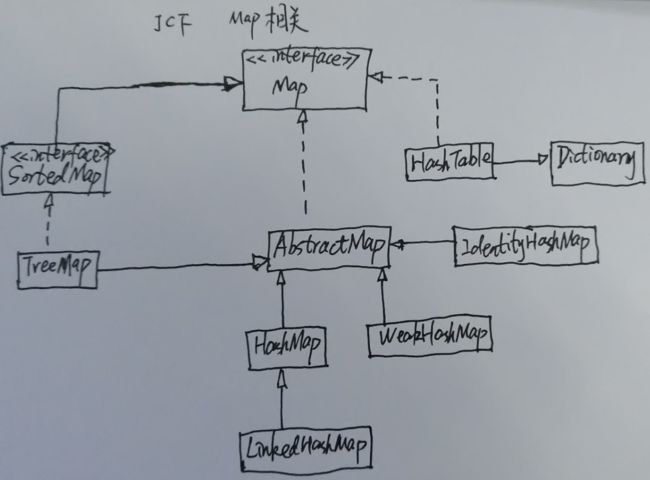前面介绍了List和Queue相关源码,这篇开始,我们先来学习一种java集合中的除Collection外的另一个分支------Map,这一分支的类图结构如下:
这里为什么不先介绍Set相关:因为很多Set实现类是通过对应的Map来实现,使用Map中key不能重复的特性,往Set中add元素的本质就是Map的put(),这里先介绍Map,后续介绍Set的时候再做具体介绍
首先,我们来看Map接口:
/**
Map将key映射到value(存储键值对);
一个map不能存在重复的key;
一个key最多可以映射到1个value;
这个接口用来替换Dictionary抽象类;
* @since 1.2
*/
public interface Map {
// Query Operations
int size();
boolean isEmpty();
boolean containsKey(Object key);
boolean containsValue(Object value);
// 按照指定键获得相对应的值;
// 如果不能存在指定键值对则返回null;
V get(Object key);
// Modification Operations
// 可选操作;添加指定键值对
V put(K key, V value);
// 可选操作;
// 移除指定键值对;
// 返回移除前key对应的value;
V remove(Object key);
// Bulk Operations
void putAll(Map m);
void clear();
// Views
// 返回Map中所有key的视图
Set keySet();
// 返回Map中所有value的视图
Collection values();
// 返回Map中所有的Entry的视图,也即key-value的视图
Set> entrySet();
// 一个Entry就是一个键值对;
interface Entry {
K getKey();
V getValue();
V setValue(V value);
boolean equals(Object o);
int hashCode();
}
// Comparison and hashing
boolean equals(Object o);
int hashCode();
} 和所有集合接口一样,Map接口主要是定义键值对相关的增删改查的操作,考虑到实现不可修改的Map的实现,其中增加(其实也包括修改)和删除都是可选操作.
Map接口中必须实现的方法主要是围绕着查找遍历Map:
Map中提供了3种遍历方式:
- 使用
keySet()获取所有key的集合,然后用集合里面的可以获取所有value; - 使用
values()获取所有value的集合; - 使用
entrySet()获取所有key-value的集合;
其使用代码案例如下:
Set set = map.keySet();
for (Object key : set) {
System.out.println(map.get(key));
} Collection values = map.values();
Iterator iterator = values.iterator();
while (iterator.hasNext()){
System.out.println("value " + iterator.next());
} Set entrySet = map.entrySet();
for (Object o : entrySet) {
Map.Entry entry = (Map.Entry) o;
System.out.println(entry); //key=value
System.out.println(entry.getKey() + " / " + entry.getValue());
}和之前介绍的集合类一样,Map相关也提供了一个AbstractMap抽象类,提供Map的骨架实现,其所有功能都是通过entrySet()来实现,下面是其源代码:
为了简略篇幅,这里只列出部分具代表性的方法源码,具体可以参考
jdk源码
/**
* 提供Map接口的骨架实现;
* 如果要实现一个不可修改的map,只需要继承该类,并实现entrySet方法,其返回的Set应不可修改;
* @since 1.2
*/
public abstract class AbstractMap implements Map {
protected AbstractMap() {}
// Query Operations
public int size() {
return entrySet().size();
}
public boolean isEmpty() {
return size() == 0;
}
public boolean containsValue(Object value) {
// ...
}
public boolean containsKey(Object key) {
// ...
}
// 通过entrySet()来实现,其实所有的方法都是通过entrySet()来实现
public V get(Object key) {
Iterator> i = entrySet().iterator();
if (key == null) {
while (i.hasNext()) {
Entry e = i.next();
if (e.getKey() == null)
return e.getValue();
}
} else {
while (i.hasNext()) {
Entry e = i.next();
if (key.equals(e.getKey()))
return e.getValue();
}
}
return null;
}
// Modification Operations
// 默认不允许添加键值对
public V put(K key, V value) {
throw new UnsupportedOperationException();
}
// 通过entrySet()实现,如果entrySet()不支持移除,其remove()会抛出UnsupportedOperationException
public V remove(Object key) {
Iterator> i = entrySet().iterator();
Entry correctEntry = null;
if (key==null) {
while (correctEntry==null && i.hasNext()) {
Entry e = i.next();
if (e.getKey()==null)
correctEntry = e;
}
} else {
while (correctEntry==null && i.hasNext()) {
Entry e = i.next();
if (key.equals(e.getKey()))
correctEntry = e;
}
}
V oldValue = null;
if (correctEntry !=null) {
oldValue = correctEntry.getValue();
i.remove();
}
return oldValue;
}
// Bulk Operations
public void putAll(Map m) {
for (Map.Entry e : m.entrySet())
put(e.getKey(), e.getValue());
}
public void clear() {
entrySet().clear();
}
// Views
transient volatile Set keySet = null;
transient volatile Collection values = null;
public Set keySet() {
// ...
}
public Collection values() {
// ...
}
// entrySet()仍然为抽象方法,待子类实现
public abstract Set> entrySet();
// Comparison and hashing
public boolean equals(Object o) {
// ...
}
public int hashCode() {
// ...
}
public String toString() {
// ...
}
protected Object clone() throws CloneNotSupportedException {
// ...
}
private static boolean eq(Object o1, Object o2) {
return o1 == null ? o2 == null : o1.equals(o2);
} 除了上面的之外,在jdk1.6之后,AbstractMap还提供了SimpleEntry和SimpleImmutableEntry两个静态内部类,其均实现了Map.Entry接口,两者的唯一区别为SimpleImmutableEntry不支持修改key对应的value,其setValue()如下:
public V setValue(V value) {
throw new UnsupportedOperationException();
}SimpleEntry的源代码如下,没有什么需要特别讲解的:
/**
* @since 1.6
*/
public static class SimpleEntry implements Entry, java.io.Serializable {
private static final long serialVersionUID = -8499721149061103585L;
private final K key;
private V value;
public SimpleEntry(K key, V value) {
this.key = key;
this.value = value;
}
public SimpleEntry(Entry entry) {
this.key = entry.getKey();
this.value = entry.getValue();
}
public K getKey() {
return key;
}
public V getValue() {
return value;
}
public V setValue(V value) {
V oldValue = this.value;
this.value = value;
return oldValue;
}
public boolean equals(Object o) {
if (!(o instanceof Map.Entry))
return false;
Map.Entry e = (Map.Entry) o;
return eq(key, e.getKey()) && eq(value, e.getValue());
}
public int hashCode() {
return (key == null ? 0 : key.hashCode()) ^ (value == null ? 0 : value.hashCode());
}
public String toString() {
return key + "=" + value;
}
} 